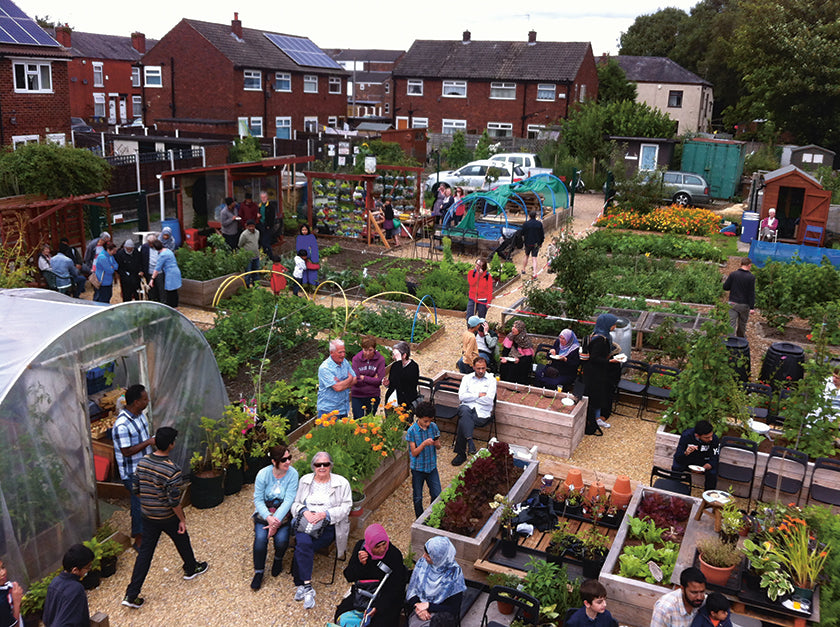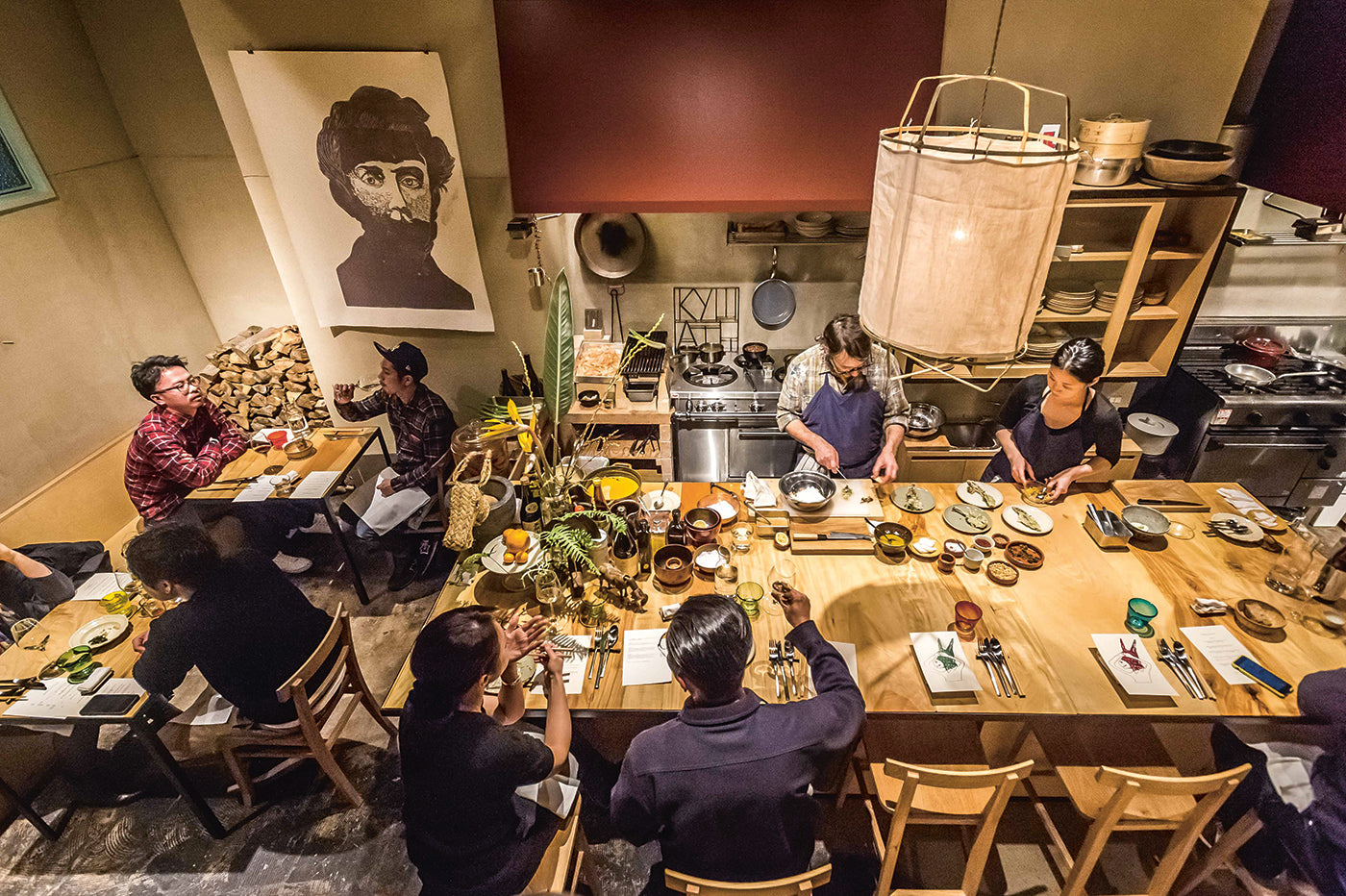Your Cart is Empty
When you buy a book, we plant a tree
The culinary world abounds with people driven by the same desire: to build stronger communities through the time-honored tradition of getting strangers together

Every evening at six o’clock, two hundred people flow through the entrance of Absalon, a converted church in Copenhagen’s Vesterbro neighborhood, find a seat at one of its 27 long tables, and sit down for dinner with strangers. The food is homey, comforting, and served “family style” to encourage conversation around the table. At Absalon’s nightly fællesspisning—or communal meal—people from all walks of life are welcome and strangers fast become friends. Sharing food is one of the simplest pleasures in life. While social media might provide a sense of community when it comes to building communities, is there really any substitute for sitting down and breaking bread with people?

The desire for company and companionship perhaps explaining the rise of pop-up dinners and supper clubs. In our highly atomized, deeply divided world, few things open doors or bring people together quite like food. And where better to share stories about culture, society, and tradition than around the dinner table? After all, food is a language that everybody understands.
The desire to gather for food may also explain the growing number of street-food markets around the world. These down-to-earth gastronomic hubs are flourishing for many reasons, from the extraordinary range of cuisines they offer to the way they’ve helped democratize the industry by giving budding chefs a way to prove their concept and test their mettle without the risk of opening a brick-and-mortar café or restaurant.
Pam Warhurst in Delicious Places describes her idea for the food-growing initiative Incredible Edible as coming to her “like a bolt from the blue.” She was sitting on a train from London to Manchester when she decided to put local food at the heart of her community in Todmorden, a leafy village in northern England. Now more than a decade old, Incredible Edible is dedicated to growing food locally by planting food on unused land. In Todmorden today, orchards grow alongside playing fields, and herb gardens sprout beside bus shelters.

As well as encouraging residents of the village to grow food in public spaces, Incredible Edible encourages them to share any relevant skills and support local businesses. Thus, it is not only an example of building communities through the power of food but also of supporting local initiatives.

The idea behind Vollpension, a café in the Austrian capital of Vienna, is equally simple: “Who makes the best cake or the tastiest soup? Grandma, of course.” Founded in 2012 by social entrepreneur Hannah Lux, Vollpension employs seniors is to help combat loneliness and poverty in old age. Inevitably, the food served at Vollpension is pretty good.
But Vollpension is also about community, about bringing many different people together. In this respect, it’s a social project that bridges cultures and generations while providing a gateway to other people’s lives through food. “A warm, seasonal, and delicious meal shared at a table with others is much more than the sum of its ingredients,” says Lara Gilmore, the wife of Italian star chef Massimo Bottura.
The couple founded Food For Soul, a not-for-profit initiative that sets up community kitchens around the world to help combat food waste while promoting social inclusion. To date, Food for Soul has launched four such kitchens, including Refettorio Felix at St. Cuthbert’s, a community kitchen in west London that offers lunch to homeless people and other socially isolated individuals.

Each month Refettorio transforms more than 2,000 lb. (1,200kg) of so-called food waste into 1,100 nourishing meals. Bottura, whose Modena restaurant Osteria Francescana boasts three-Michelin stars, says: “The gesture of sitting down to a meal and breaking bread together is the first step toward rebuilding dignity and creating community.”
“When several refugees set up camp at Oranienplatz in Berlin in 2013, four students thought about how best to get in touch with the local people,” says Katja Elsner about the origins of Über den Tellerrand, an initiative that uses food as a portal to different cultures. “So they took a gas stove and food with them to Oranienplatz and simply started cooking with the people.” Literally meaning “beyond your plate,” Über den Tellerrand takes its name from a German expression for open-mindedness. In particular, the initiative aims to help refugees and other newcomers integrate into society and develop a sense of belonging.
By giving Syrian refugees a way to introduce native Berliners to their homemade food through cooking classes, Über den Tellerrand makes it possible for people from different backgrounds and cultures to connect. Cities have long been cultural melting pots—with food both driving the cultural exchange and benefitting from it. Think of the döner kebab, which Turkish immigrants introduced to Germany in the 1950s and 1960s, or the huge range of cuisines from Asia, Africa, and the Americas you can find in cities such as London and New York. By welcoming refugees with open arms, projects such as Über den Tellerrand use the power of food to strengthen their communities and have a positive impact on society.
Then there are initiatives such as Eatwith.com, which also uses food to expand horizons. Founded in 2014 by Jean-Michel Petit and Camille Rumani, it’s the world’s largest community for authentic food experiences with locals. In essence, Eatwith.com is a web-based platform that allows people to “share unique dinners, cooking classes, food tours, and supper clubs with hand-selected hosts.” Thanks to Eatwith.com, the adventurous traveler can now dine on a houseboat in Amsterdam, take a cooking class in Tokyo, or even eat an Italian feast with a family in Rome.

At the heart of the platform’s success is its community—its global network of people who want to provide bona fide culinary experiences to travelers. After all, what is more, authentic than discovering a local cuisine, with all its distinct customs and ingredients? And is there a more immersive, more intimate way to discover a new food culture than under someone’s roof or at their own table? As the civil rights activist Cesar Chavez put it: “If you really want to make a friend, go to someone’s house and eat with him… The people who give you their food give you their heart.”
Faced with deadlines and other demands, many people struggle to sit down for a proper meal during the day at work. For some, lunch is a sandwich grabbed on the go. For others, it’s a meal typically eaten al desko—hunched over the keyboard, staring at the screen. Which begs the question: if we don’t eat with colleagues, what does that do to our workplace community? That, at least, is the reason behind the growing popularity of canteens and cafeterias that provide communal meals for local workers or colleagues at the same company. Eschewing the bad old days of individuals eating lunch alone, the new generation of workplace canteens seek instead to encourage conversation and foster community spirit. Food is the social glue that forces workers to put down their tools, take a screen break, and take time to connect with one another.

For example, Tuck Shop is located in file-sharing giant Dropbox’s Silicon Valley headquarters, it’s a cafeteria that serves gourmet meals for breakfast, lunch, and dinner. Think roasted lamb chops with butternut pumpkin purée, lavender-honey glaze, and lamb jus. Or, for dessert, a pumpkin panna cotta tart with cardamom whipped-cream, maple-poached cranberries, and candied pumpkin seeds. Everything is made from scratch: Tuck Shop even grows its own microgreens.
For Dropbox employees, everything is free. Predictably perhaps, corporate cafeterias are a common perk in Silicon Valley today. Employees at Bay Area start-ups Asana and Stripe have their own fancy canteens, too. Then there’s SOE (Studio Olafur Eliasson) Kitchen, which is housed in the Berlin studio of the acclaimed Icelandic-Danish artist Olafur Eliasson. The New York Times described it as “not quite a staff canteen and not quite an art studio.” Indeed, it’s where the studio’s staff of 120 gathers four times a week for a communal lunch. A vegetarian meal is cooked by a kitchen team that includes Eliasson’s sister, Victoria Elíasdóttir, who formerly worked at Dottir, a seafood restaurant in Berlin. A typical dish at SOE Kitchen might be garlic Shio Koji tofu served with leek, chard, black radish, and miso-sesame sauce, or beet soup with horseradish crème fraîche.

However, the point of the communal lunch isn’t so much about delicious food as it is about providing inspiration: the meal often features a talk by a visiting it’s also to build friendships and strengthen the collegial bonds between the staff at Eliasson’s studio.
Then there are places such as Saltimporten Canteen, a restaurant located in a warehouse in the southern Swedish city of Malmö. It’s only open for weekday lunch and it offers diners just two simple but wholesome dishes—lamb with tomatoes, nuts, and chili, say, or zucchini with lentils, raisins, and spinach. Moreover, Saltimporten Canteen operates as a de facto workplace cafeteria for the handful of companies that moved into the neighborhood in recent years. Pretty much everyone who leaves the office at lunchtime and grabs a seat at one of Saltimporten Canteen’s long tables does so for the same reasons; for healthy and delicious food, of course, but also because they understand the value of sharing meals with others—with colleagues and locals.
Explore a new wave of food culture through Delicious Places.